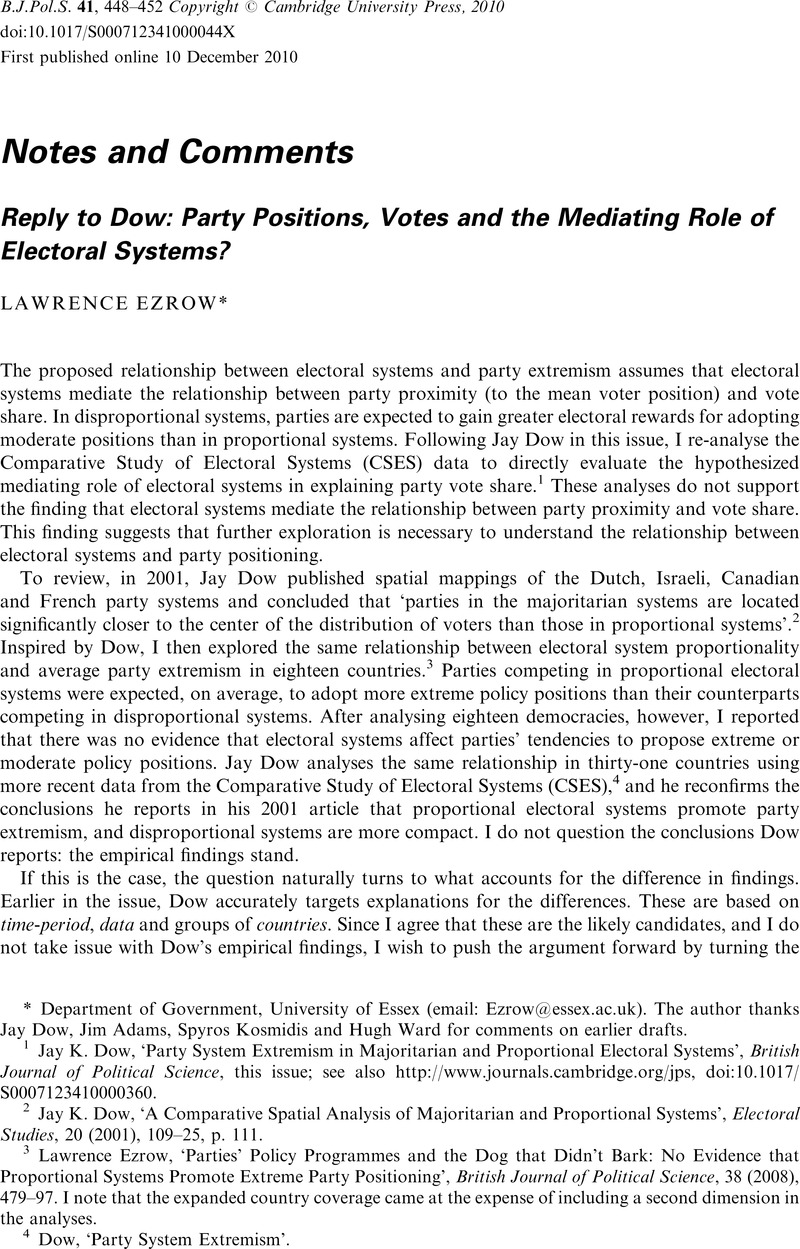Article contents
Reply to Dow: Party Positions, Votes and the Mediating Role of Electoral Systems?
Published online by Cambridge University Press: 10 December 2010
Abstract

- Type
- Notes and Comments
- Information
- Copyright
- Copyright © Cambridge University Press 2010
References
1 Dow, Jay K., ‘Party System Extremism in Majoritarian and Proportional Electoral Systems’, British Journal of Political Science, this issue; see also http://www.journals.cambridge.org/jps, doi:10.1017/S0007123410000360CrossRefGoogle Scholar.
2 Dow, Jay K., ‘A Comparative Spatial Analysis of Majoritarian and Proportional Systems’, Electoral Studies, 20 (2001), 109–125CrossRefGoogle Scholar, p. 111.
3 Ezrow, Lawrence, ‘Parties’ Policy Programmes and the Dog that Didn’t Bark: No Evidence that Proportional Systems Promote Extreme Party Positioning’, British Journal of Political Science, 38 (2008), 479–497CrossRefGoogle Scholar. I note that the expanded country coverage came at the expense of including a second dimension in the analyses.
4 Dow, ‘Party System Extremism’.
5 Dow, ‘Party System Extremism’. See also Dow, ‘A Comparative Spatial Analysis’; Ezrow, ‘Parties’ Policy Programmes and the Dog that Didn’t Bark’.
6 Dow, ‘Party System Extremism in Majoritarian and Proportional Electoral Systems’, p. 5.
7 The Comparative Study of Electoral Systems (www.cses.org), CSES Module 1, Full Release [dataset] (Ann Arbor: University of Michigan, Center for Political Studies, 4 August 2003); The Comparative Study of Electoral Systems. CSES Module 2, Full Release [dataset] (Ann Arbor: University of Michigan, Center for Political Studies, 27 June 2007).
8 An alternative set of analyses was performed based on the parties’ linear proximities to the mean voter position. These analyses supported substantive conclusions that were identical to the ones reported below, although the statistical fit of these models was not as strong as the fit for squared proximity, suggesting that this latter measure is the appropriate metric for evaluating the electoral effects of party positioning. This empirical finding suggests that the parties’ vote shares are concave functions of their policy positions, i.e. that parties’ vote shares drop off slowly at first as they diverge from their vote-maximizing positions, but then drop off more rapidly as the parties move further away. For theoretical arguments about why parties’ vote shares can be expected to be concave functions of their positions, see Adams, James and Merrill, Samuel III, ‘Parties’ Policy Platforms and Election Outcomes: The Three Faces of Policy Representation’, European Journal of Political Research, 44 (2005), 899–918CrossRefGoogle Scholar. This can be interpreted to mean that parties are penalized more for each marginal unit further away they are from the mean voter position.
9 Ezrow, Lawrence, ‘Are Moderate Parties Rewarded in Multiparty Systems? A Pooled Analysis of Western European Elections, 1984–98’, European Journal of Political Research, 44 (2005), 881–898CrossRefGoogle Scholar.
10
Gallagher, Michael, ‘Proportionality, Disproportionality and Electoral Systems’, Electoral Studies, 10 (1991), 33–51CrossRefGoogle Scholar. The equation for the Index of Disproportionality is ![]() , where vi and si are the vote shares and subsequent seat shares for party i.
, where vi and si are the vote shares and subsequent seat shares for party i.
11 The equation for the Effective Number of Parties is based on parliamentary seats: N = 1/Σsi 2, where si is the proportion of seats of the ith party (see Laakso, Markku and Taagepera, Rein, ‘ “Effective” Number of Parties: A Measure with Application to West Europe’, Comparative Political Studies, 12 (1979), 3–27CrossRefGoogle Scholar).
12 See also Golder, Matt and Stramski, Jacek, ‘Ideological Congruence and Electoral Institutions’, American Journal of Political Science, 54 (2010), 90–106CrossRefGoogle Scholar.
13 Additional empirical analyses have been conducted that measure party policy distance based on linear losses. The mediating effect of electoral systems has been estimated for countries and elections included in the Eurobarometer surveys for the 1980s and 1990s (see Ezrow, Lawrence, Linking Citizens and Parties: How Electoral Systems Matter for Political Representation (Oxford: Oxford University Press, 2010), p. 60CrossRefGoogle Scholar). The effective number of parties has been measured based on parties’ proportions of votes. Vote share has been measured relative to the sum of all of the parties’ vote shares in a given election. The parameter estimates based on these model specifications support identical substantive conclusions.
14 McCarty, Nolan, Poole, Keith T. and Rosenthal, Howard, ‘Does Gerrymandering Cause Polarization?’ American Journal of Political Science, 53 (2009), 666–680CrossRefGoogle Scholar, p. 666. See also McCarty, Nolan, Poole, Keith T. and Rosenthal, Howard, Polarized America: The Dance of Ideology and Unequal Riches (Cambridge, Mass.: MIT Press, 2006)Google Scholar.
- 19
- Cited by


